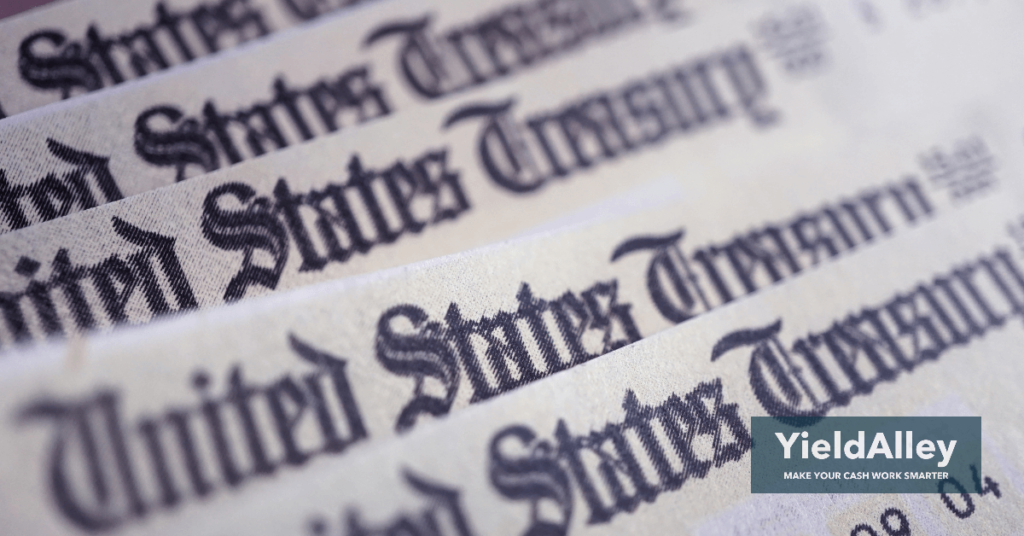Treasury Bills are short-term Treasury bonds issued by the U.S. government. They are considered to be one of the safest investments in the world, and currently Treasury bills are yielding over 5%. As a result, they’re some of the most popular cash investments for investors. Instead of keeping cash in a bank account or high-yield savings account, Treasury bills are a superior alternative for those looking to earn higher yield while maintaining liquidity.
What are Treasury Bills?
Treasury bills, or T-Bills, are debt instruments the U.S. government issues. The government issues T-Bills to raise money to fund various government programs, infrastructure development, and to manage budget deficits.
When the U.S. government borrows money from individuals, banks, and other investors, they promise to pay back this money at the end, along with interest accrued during that period.
T-Bills one of the safest investments in the world as they are backed by the full faith and credit of the U.S. government. The U.S. government guarantees the repayment to the T-Bill purchaser.
How Much Can I Make From T-Bills?
As of this article’s publication, the 1-year T-Bill rate is over 5.3%. With $20,000 worth of T-Bills, you would be making over $1,000 annually from the investment! That’s the equivalent of getting a brand-new iPhone for free every year.
The Secret Tax Advantage of T-Bills
One of the unspoken and major advantages of investing in T-Bills is that the interest earned on T-Bills is always exempt from state and local taxes.
Usually, the interest you earn from investing in products such as CDs is subject to all levels of tax, from federal tax to state and local. Depending on your state, this tax could be as high as 10%, meaning 1/10th of your returns immediately go to Uncle Sam.
T-Bill investors never have to pay state and local taxes, and only need to pay federal tax.
T-Bills vs. CDs
T-Bills and CDs (in this case, we’ll reference brokered CDs, which are far superior to normal bank CDs) have much in common regarding risk and return but are ultimately different cash investments.
A few similarities include:
- Similar risk: T-Bills and CDs are considered low-risk investments. They are backed by the full faith and credit of the government (in the case of T-Bills) or by the issuing bank (in the case of CDs) through FDIC insurance.
- Fixed income: Both T-Bills and CDs provide fixed income to investors. They offer a predetermined interest rate or yield, allowing investors to know how much they will earn.
- Short-term maturity: T-Bills and CDs have short-term maturity periods. T-Bills have a maximum maturity of 52 weeks, while short-term CDs have maturities from 3 months to a year.
- Liquidity: T-Bills and brokered CDs are liquid and can be easily sold or redeemed before maturity. T-Bills are more liquid than brokered CDs.
- Easy to purchase: T-Bills and CDs can be purchased through brokerage firms, and T-Bills can be directly purchased from the government. Both are relatively straightforward investments to acquire.
Differences between T-Bills and CDs:
- Different issuers: T-Bills are issued by the U.S. Department of the Treasury, while banks or credit unions issue CDs.
- Government guarantee: T-Bills are backed by the U.S. government, meaning they have extremely low default risk. CDs are backed by the bank that issues them. There is sometimes minor default risk with lesser-known banks, but as long as the bank is FDIC insured, the FDIC insures your investment up to $250,000.
- Secondary market: T-Bills have an active secondary market where investors can buy and sell them before maturity. Brokered CDs also have an active secondary market, but it’s not as active as the T-Bill market.
- Minimum investment: T-Bills typically have a minimum investment requirement of $100, while brokered CDs may usually have a higher minimum investment amount of $1,000.
- Interest payment: T-Bills are sold at a discount to their face value and do not pay periodic interest. Instead, investors earn interest by the difference between the purchase price and the face value at maturity. On the other hand, CDs pay periodic interest, which can be received monthly, quarterly, or annually.
You can also read our detailed comparison that covers treasury bills vs. brokered CDs.
I Have $10k in Cash. Should I Buy T-Bills?
If you have $10k in cash sitting in your savings or checking account, you are missing out on considerable risk-free interest, and should strongly consider buying T-Bills.
T-Bills are typically sold in increments of $1000 and have maturities ranging from a few days to one year. They offer a fixed interest rate, usually lower than other investment options, but they’re virtually risk-free and can be easily liquidated if you need cash.
If you want higher but unpredictable returns, you can consider stocks or other types of bonds.
I’m Convinced. How Do I Buy T-Bills?
There are two primary ways to purchase T-Bills.
The first way is to buy T-Bills through your brokerage accoun. The second is through TreasuryDirect, the official platform to buy U.S. Treasuries from the U.S. Treasury Department. We prefer purchasing on bokrerages given the better user experience, ease of use, and the ability to manage all your other non-Treasury Bill investments on a single platform.
If you’re exploring other Treasury investments such as Series I Bonds and TIPS, it’s worth noting that Series I Bonds, which is a savings bond with inflation protection, are exclusively available on TreasuryDirect. TIPS, which has a fluctuating principal indexed to inflation instead of a changing rate, are accessible both on TreasuryDirect and through brokerages.
Buying T-Bills Through Your Broker
Almost all major brokerages offer the ability to buy Treasury bills.
- If you don’t already have one, open an investment account with a brokerage firm. This can usually be done in a few minutes.
- You often purchase T-Bills through the firm’s online trading platform or by speaking with a representative.
- Each brokerage platform will generally list T-Bills under the Fixed Income and Bonds category.
- Select the T-Bill you want to purchase, including the maturity date and amount, and place your order.
- You can track your T-Bill investments through your brokerage, generally in your Account or Portfolio sections.
Buying T-Bills Through TreasuryDirect
The U.S. Department of the Treasury sells T-Bills directly to the public through its website, TreasuryDirect. Here’s how you can buy T-Bills through TreasuryDirect:
- Create an Account: Visit the TreasuryDirect website and create an account.
- Link Your Bank Account: You’ll need to link a bank account to fund your purchases.
- Select the T-Bill: Choose the specific T-Bill you want to buy, including the maturity date and amount.
- Place Your Order: Follow the prompts to complete your purchase.
- Manage Your Investments: You can manage your T-Bills and other Treasury securities through your TreasuryDirect account.
The TreasuryDirect platform can be less user-friendly, and can only be used to buy and sell Treasuries. If you are interested in buying multiple T-Bills with different maturies to build a T-Bill ladder, it’s easier to manage on a brokerage instead of TreasuryDirect.
What Happens When My T-Bill Matures? T-Bill Redemptions and Interest Earned Explained
T-Bills are sold at a discount from their face value, which means that investors purchase them for less than their nominal value. T-Bills do not pay out interest periodically like other fixed-income securities such as CDs.
An example of buying a 1-year T-bill at a discount when the interest rate is 5.3% would be purchasing a T-Bill with a face value of $10,000 for $9,470. At the end of the 1-year maturity period, you would receive the full face value of $10,000, earning a profit of $530 or 5.3% on the investment.
Once the T-Bill reaches maturity, the investor receives the full face value of the bill. The Treasury Department usually does the redemption automatically, so the investor does not need to take any action to collect the payment. The funds are typically deposited into the investor’s designated bank or brokerage account.
A Quick Note on Treasury Bills vs. Other Treasury Instruments
There are three main forms of Treasury securities: Treasury Bills (T-Bills), Treasury Notes (T-Notes), and Treasury Bonds (T-Bonds).
They largely differ in maturity length. T-Bills have a short-term maturity that ranges from a few days up to 52 weeks. T-notes mature from 2 to 10 years, whereas T-bonds are even longer-term with 20-30 years maturities. Generally, the longer the maturity, the less liquid the secondary market is.
In addition, T-Bills do not pay periodic interest, are sold at a discount, and mature at face value. The difference between the purchase price and face value represents the interest income. Both T-notes and T-bonds pay interest payments every six months.
All three forms are backed by the U.S. government, making them all virtually risk-free.
In 2014, the U.S. Treasury introduced floating rate notes, which pay an interest rate indexed to the 13-week T-bill rate, instead of the fixed rate that T-bills pay.
Wrapping It All Up: Should I Buy T-Bills?
T-Bills are among the most attractive investments available today to replace cash. While a boring investment, T-Bills are currently offering extremely high yields and have the full backing of the U.S. government, which means guaranteed money back. For residents in states with high income taxes, the state tax exemption is another boon to returns. T-Bills offer umatched liquidity if you need cash, making it a superior alternative to park money instead of a bank or savings account.






